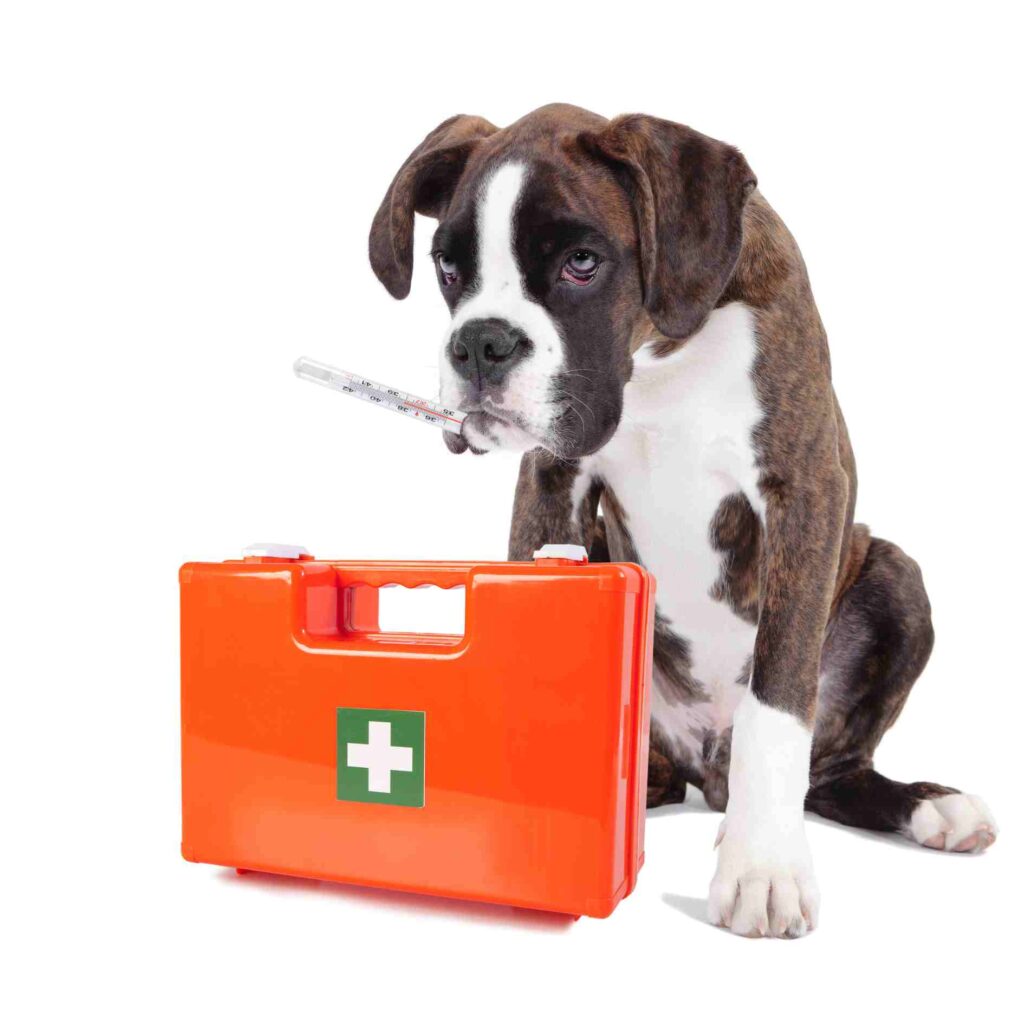Understanding if your dog has a fever can often feel like piecing together a puzzle with no clear image to guide you. After all, your furry friend can’t just say, “Hey, I’m feeling under the weather today.” Instead, signs such as red eyes and lethargy hint that something isn’t right. Your dog’s normal body temperature should range between 99.5 to 102.5 degrees Fahrenheit, so anything above this could be a fever.
When your pup seems off, you might wonder (and worry) what’s going on. Could it be a fever, or is it something else? Getting to the bottom of this mystery not only puts your mind at ease but it’s also crucial for your dog’s health. Let’s uncover the symptoms that indicate a fever and explore the steps you’ll need to take a temperature reading correctly. Imagine gently coaxing your dog to sit still as you check if they’re running a temperature—yes, that’s definitely easier said than done, isn’t it?
Key Takeaways
- Recognizing abnormal behaviors and physical symptoms can indicate whether your dog has a fever.
- Accurately measuring your dog’s temperature is essential in confirming if they have a fever.
- Proper care, including identifying the cause and seeking treatment, is vital for a feverish dog.
Recognizing Signs of Fever in Dogs
When you cozy up with your furry friend, you might notice something off, maybe it’s the warmth that doesn’t feel quite right. Your intuition could be pointing towards a fever. A dog’s normal temperature should range between 100 to 102.5 degrees Fahrenheit, so anything above this could indicate their body is fighting an infection or illness.
Here are some signs to watch for:
- Elevated body temperature: Above 103°F is worrisome, and over 104.5°F is a red flag.
- Lethargy: If your pup, usually brimming with energy, seems unusually sluggish or indifferent, it could be a cry for help (think of it as them saying, “Hey, I’m not feeling too hot”).
- Loss of appetite: When they turn their nose up at a usually irresistible bowl of kibble, take note.
- Vomiting or diarrhea: These unpleasant symptoms may accompany a fever, much like a rude, unwanted guest.
- Red eyes or nasal discharge: These could be subtle hints that your dog’s body is under the weather.
Getting a precise temperature requires a pet thermometer (be sure it’s for rectal or ear use).
When you observe any combination of these symptoms, it’s essential to contact your vet. They’re your ally in your dog’s health and can guide you on the best course of action. Remember, you’re the eyes and ears on the ground for your pooch’s well-being, so stay vigilant and lovingly attentive.
Measuring Your Dog’s Temperature

Knowing the proper technique to measure your dog’s temperature is crucial. You’ll be (thankfully) more confident in detecting a fever early on, which can be a lifesaver.
Choosing the Right Thermometer
When it comes to measuring your dog’s temperature, selecting a reliable thermometer is your first step. An ear thermometer designed specifically for dogs is a hassle-free option that’s less intrusive. On the other hand, a rectal thermometer might be more accurate. Consider a digital thermometer for ease of use—its quick readouts can be a game changer in stressful situations. (You’re probably thinking, “Quick and easy? Count me in!”)
Taking a Rectal Temperature
Don’t shy away from using a rectal thermometer; it’s not as daunting as it sounds. First, apply a smidge of petroleum jelly to the thermometer for a gentler insertion. Carefully slide it 1-2 inches into your dog’s rectum and wait for the beep—usually a minute. Remember, your dog’s normal body temperature should range between 99.5°F and 102.5°F. If it’s higher, it’s time to call your vet. Make sure the thermometer is cleaned before and after each use. (And you’re definitely thinking, “A little awkward, but we can do this, right?”)
Assessing Temperature Without a Thermometer
Now, if you find yourself without a thermometer, you can sometimes get a general idea of your dog’s condition. Feel behind the ears and paws; if they’re abnormally warm, that could indicate a fever. Checking your dog’s gums for excessive redness can also be a clue. None of these methods are as reliable as using a digital ear thermometer or rectal one, but they can alert you about when to seek a proper reading. (You’re wondering, “How warm is too warm?” Always better to check with a thermometer to be sure!)
Understanding and Addressing Causes of Fever
When your loyal companion’s normal behavior shifts, it may be a telling signal that something’s amiss. Fevers in dogs often suggest an underlying ailment—knowing the common triggers helps you seek timely care.
Common Illnesses and Infections
Your furry friend’s fever could likely be waving a red flag about an infection or disease. Dogs are prone to conditions like lyme disease, which they can contract from tick bites, or leptospirosis, a bacteria spread by wildlife and potentially contaminating water sources. Don’t forget about urinary tract infections; these are not uncommon and can definitely result in a feverish state. Be extra vigilant after your dog’s been playing in tall grasses or drinking from standing water (you’re picturing those dirty park puddles, aren’t you?).
A temperature spike can also follow vaccinations, thus you might notice your pup’s not their usual self post-vet visits. It’s usually short-lived, but keep an eye on them—imagine how you’d feel after getting a shot!
Environmental and Toxin-Related Fevers
Sometimes, the culprit isn’t a bug but the very environment around your pooch. Overexertion on a hot day or being trapped in an overheated space can catapult your dog’s temperature. Picture you both on that sun-drenched hike (pack more water next time, alright?).
And, let’s face it, dogs gnaw and gobble random things despite your protests. Exposure to toxins—from household chemicals to unsafe foods—can induce a fever. Be cautious of what’s within your dog’s curious reach. Remember the last time you found Fido chewing on something mysterious and thought “What’s in your mouth now?” That’s the kind of stuff to watch out for.
Treatment and Care for Dogs with Fever
When your furry companion is burning up with fever, quick action coupled with gentle care can make all the difference. It’s crucial to distinguish between solutions you can administer at home and those that warrant a vet’s intervention.
Veterinary Care and Medications
If you suspect your dog has a fever, your first step should be to contact your vet. High temperatures can signify infections, inflammation, or even more severe conditions like hyperthermia or heat stroke, which often require professional attention. Do not give human medicines, such as aspirin or ibuprofen, to your dog; these can be toxic. Your vet might prescribe antibiotics if an infection is present or recommend intravenous fluids to prevent dehydration, especially if your dog isn’t drinking water. Remember, only give medications that are specifically prescribed for your dog.
Home Care and Remedies
While you wait for your veterinary appointment, keep your dog comfortable: offer plenty of fluids to stave off dehydration and keep them in a cool place to help reduce their temperature. You may feel like a nurse (and a worried one at that), but avoid the urge to treat with over-the-counter meds; even seemingly benign drugs like acetaminophen can be harmful. Instead, focus on monitoring your dog closely – keeping an eye on symptoms and behavior is essential. Simple home remedies, like a cool cloth on their paws and ears, can help soothe your pet, but these are minor aids and not a replacement for professional care.

Frequently Asked Questions
Sometimes, your intuition whispers (maybe even shouts) that your furry friend isn’t feeling quite right. Fever in dogs can be sneaky, but your keen observation can often spot the subtleties.
What signs would indicate my dog might have a fever?
When your dog’s usual zest for life dims, and their eyes might not have the usual sparkle, fever could be to blame. Look for unusual lethargy or redness in the eyes, as these are common signs your pup isn’t well.
How can you assess if a dog has a fever by touch?
Feeling your dog’s nose—though not a definitive test—can sometimes give you clues. A dry, hot nose could suggest a fever, but remember, it’s not a conclusive sign. You know your dog best, so trust your gut if something seems off.
What should I do if my dog seems warmer than usual and is showing signs of fever?
Your first step should be contacting your vet. It’s critical not to treat with human medications such as ibuprofen, which are harmful to dogs, as mentioned in the PetMD article.
If my dog is lethargic and not eating, could that mean it has a fever?
Absolutely, those can be red flags. Dogs with fevers often lose their appetite and seem unusually tired. If this sounds like your pup, it’s a cue to reach out to your vet.
What is the normal temperature range for a healthy dog?
A dog’s normal temperature should be between 101 and 102.5°F. Higher temperatures warrant attention, as detailed by Betterpet.
How can I gently reduce my dog’s fever at home?
While some sources advocate for cooling measures, it’s vital to get a vet’s guidance first. A vet can recommend safe methods for reducing a fever at home, such as providing cool water to drink and ensuring a comfortable resting place. Remember, a fever can mean your dog needs medical attention, so don’t delay that call to the vet.





